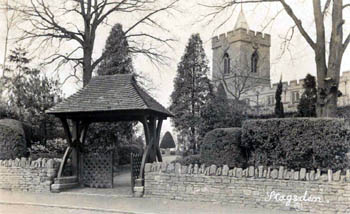
Stagsden church about 1908 [X291/186/80]
Volume 81 published by Bedfordshire Historical Records Society (2002) is a series of episcopal visitations edited by former County Archivist Patricia Bell. At each visitation a list of questions was sent out in advance, one of which enquired about the provision of schools in each parish. The various replies were as follows:
- 1706: "There is no School but of small Children, kept by one Thomas Smith, a Dissenter";
- 1717: "Schools: My Lord, There is none";
- 1720: "Schools: No".
In 1818 a Select Committee was established to enquire into educational provision for the poor. This was no doubt prompted, in part, by the recent foundation of two societies promoting education and specifically the building of schools. The Society for Promoting the Lancasterian System for the Education of the Poor was established in 1808 promoting schools run along the lines pioneered by Joseph Lancaster, who had himself copied those of Dr.Andrew Bell, in which older children taught their younger fellows. The Society was renamed the British and Foreign School Society in 1814,. It was supported by a number of prominent nonconformists, Lancaster himself was a Quaker, and sought to teach a non-sectarian curriculum. In answer to this perceived nonconformist takeover of local education the National Society was firmed in 1811 to encourage the teaching of poor children along Anglican lines, including the catechism. The Select Committee sent a questionnaire to all parishes in the country asking for: particulars relating to endowments for the education of children; other educational institutions; observations of parish needs etc. The return for Stagsden record no educational endowment but notes: "a Free School containing 12 scholars, belonging to the parish, supported by voluntary contributions, amounting to £22 per ann. which the master receives; and a Sunday school consisting of 25 girls and 35 boys. The poor are desirous of having their children educated". In those days a Sunday School was just that, a school which met on a Sunday, usually in the church or nonconformist chapel or other similar building, teaching more than the religious topics with which they are associated today.
In the country generally the number of schools built continued to grow over the next fifteen years so that by 1833 the government agreed to supplement the work of the two societies, and local benefactors, by making £20,000 per annum available in grants to help build schools. It also prompted another questionnaire to be sent to each parish in England asking for details of local educational provision. The return for Stagsden reads as follows: "One Day and Sunday School (commenced 1828) attended by 33 boys and 12 girls daily, and 48 males and 53 females on Sundays; the funds are £30 per annum, of which £6 arises from a reputed endowment [so much for the accuracy of the 1818 return]; £12 is given by the Hon.G.R.Trevor, and the residue charged to the poor-rates, for which £30, 28 day and all the Sunday scholars are instructed; the other 17 day scholars by payments from their parents. This School has a lending Library attached. There is a Weekly School on Saturdays, in which poor girls are taught needle work".
The next national enquiry was in 1846/7 when the Church of England made an enquiry as to all its church schools. This was against the background of a new Whig government which championed secular education and the increasing importance of nonconformists, particularly Wesleyan Methodist, and Roman Catholics in providing schools. The return for Stagsden recorded a Sunday School with 72 boys and a daily school with 50 boys and 9 girls.
The Bunyan Meeting was strongly supported in Stagsden. The Bunyan Meeting archive at Bedfordshire & Luton Archives & Records Service has references to a Sunday school in the village supported by the Meeting [BY9/3] in 1863 for which new buildings were provided in 1866 and further new buildings in 1885 [BY16/1/4].
The first Education Act was passed in 1870 (more correctly it was known as the Elementary Education Act). It was a milestone in the provision of education in Britain demonstrating central government's unequivocal support for education of all classes across the country. It also sought to secularise education by allowing the creation of School Boards. These were groups of representatives, elected by the local ratepayers and the Board had the powers to raise funds to form a local rate to support local education, build and run schools, pay the fees of the poorest children, make local school attendance compulsory between the ages of 5 and 13 and could even support local church schools, though in practice they replaced them, turning them into Board run schools (known as Board Schools). Naturally, and luckily for local historians, the Act required a questionnaire of local schools in 1870. Stagsden reported that there was "no efficient school" and that "accommodation for 130 children in Stagsden" was required noting: "If the Stagsden School is at once made efficient by the appointment of a certified teacher, no further accommodation will be required".